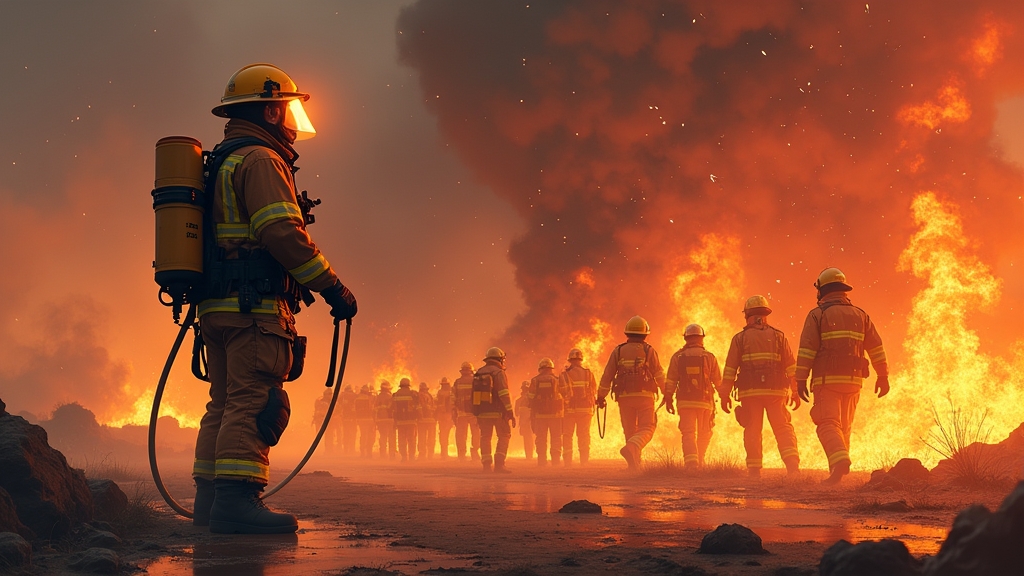The profession of firefighter is one of the most admired and respected in the world. These professionals are seen as heroes who risk their lives to save others, whether in fires, natural disasters or accidents. However, to become a skilled firefighter, you need to undergo rigorous and specialized training. In this article, we'll explore everything about the firefighter course, from the entry requirements to the skills acquired during training. If you're interested in pursuing this career or simply want to understand more about firefighter training, read on.
Requirements to join the Firefighter Course
The first step to becoming a firefighter is to meet a series of basic requirements that ensure the candidate has the right profile for the job. One of the most common criteria is the minimum age, which is usually 18. In addition, it is essential that the candidate has completed high school. This level of education is fundamental because the firefighter course involves learning complex theoretical concepts that require basic reading, writing and math skills.
Another important requirement is physical fitness. Firefighter work is physically demanding, requiring strength, endurance and agility. For this reason, many courses require candidates to pass rigorous physical tests to ensure they are prepared for training. In addition, mental and emotional health is also assessed, as the profession can be extremely stressful and emotionally demanding.
Criminal record certificates are also commonly required. This helps to ensure that candidates have a clean record, which is crucial for a profession that demands public trust and integrity. Finally, many firefighter courses require candidates to undergo an interview or selection process that assesses their motivations and behavioral competencies.
The Firefighter Course Curriculum
The firefighter course curriculum is comprehensive and designed to prepare candidates for a wide range of emergency situations. Training begins with essential theoretical foundations, such as fire science, which includes the study of the causes of fire, forms of propagation and extinguishing methods. This theoretical basis is critical, as it allows future firefighters to understand the principles behind the techniques they will use in the field.
The students then receive practical firefighting training. This includes the use of equipment such as hoses, ladders and extinguishers, as well as safety practices on the scene. The practical training is intensive and simulates real fire conditions to prepare students for situations they will face in real life. In addition, rescue techniques in burning buildings and disaster sites are taught in detail.
Another important part of the curriculum is emergency medical training. Firefighters are often the first to arrive at accident scenes, so training in first aid, cardiopulmonary resuscitation (CPR) and the use of automatic external defibrillators (AEDs) are essential components. This lifesaving training enables firefighters to stabilize victims until specialized medical assistance is available.
Finally, students learn about disaster management and emergency communication. Managing a disaster scene requires leadership skills and the ability to coordinate with other emergency teams. In addition, effective communication, both with staff and the public, is crucial to ensuring the safety and effectiveness of rescue operations.
Skills Acquired During the Course
The firefighter course is designed to develop a comprehensive set of skills that are crucial for effective performance in the profession. One of the most important skills is the ability to work under extreme pressure. Fires and other disasters can be chaotic and dangerous, requiring firefighters to make quick and effective decisions. Rigorous training prepares students to remain calm and clear-thinking in high-pressure situations.
Another fundamental skill acquired is teamwork. Firefighters rarely work alone; they are part of a highly coordinated team that relies on each member to carry out complex rescue operations. The training emphasizes the importance of collaboration and effective communication within the team, ensuring that all members are aligned and working together to achieve the common goal of saving lives.
In addition, students develop leadership skills. Even if a firefighter is not initially designated as a team leader, there are situations in which they may need to take on this role. During the course, future firefighters are trained to lead rescue operations, make rapid risk assessments and take critical decisions that can impact the safety of their team and victims.
Finally, the course trains students in specific technical skills, such as operating firefighting equipment and rescue techniques. These skills are fundamental to carrying out the daily tasks of a firefighter and are practiced exhaustively during training to ensure that graduates are well prepared to face any challenge.
Challenges and Overcomes in Training
Training to become a firefighter is not just physical; it also presents significant emotional and psychological challenges. One of the biggest difficulties faced by candidates is dealing with the stress and pressure of simulated emergency situations. The course is designed to push students out of their comfort zones by exposing them to realistic scenarios that test their ability to maintain composure and effectiveness under pressure.
Another significant challenge is the development of physical endurance. Physical training is rigorous and continuous, requiring students to maintain high levels of fitness. Many candidates face difficulties initially, but with perseverance and consistent training, most manage to overcome these barriers and develop the stamina needed for the profession.
Emotionally, the course also requires future firefighters to face simulated scenarios that can be disturbing, such as simulations of serious accidents or rescues in dangerous conditions. These exercises are fundamental to preparing students for the emotional realities of the profession, but can be challenging for those who have not yet been exposed to such situations.
However, overcoming these challenges is possible thanks to the support of the instructors and the camaraderie among fellow students. Students learn to trust each other and work together to overcome difficulties, creating a strong sense of community and support that is essential in the firefighting field.

Careers after graduation
Once they have completed the firefighter course, graduates have a variety of career options available to them. The most obvious career is to become a full-time firefighter in a local fire department. This involves responding to emergencies, carrying out safety inspections and taking part in community fire prevention education activities. The demand for qualified firefighters is high, and many graduates find employment quickly after completing the course.
In addition to service in a traditional fire department, there are opportunities in specialized areas such as forest firefighting, water rescue or hazardous materials operations. Each of these specializations requires additional training, but offers firefighters the chance to develop unique skills and work in different environments.
Another career option is to work in fire safety in private sectors. Many companies, especially those in the industrial or chemical sectors, hire firefighters to ensure that their operations are safe and to respond to emergencies on site. These jobs can offer competitive salaries and additional benefits.
Finally, some firefighters choose to pursue careers in emergency medical services or disaster management. The experience and training received during the firefighter course form a solid foundation for these fields, allowing individuals to advance in their careers and take on leadership roles in emergency situations.
The Importance of Continuing Education
Even after completing the firefighter course and starting your career, continuing education is crucial to maintaining and improving your skills. The field of firefighting and rescue is constantly evolving, with new technologies and techniques being developed regularly. To remain effective and safe, firefighters must continue their professional development throughout their careers.
Refresher courses and workshops are often offered by fire academies and professional organizations. These programs cover a variety of topics, from new safety regulations to advances in firefighting equipment. Participating in these continuing education opportunities ensures that firefighters are always informed about the best practices and innovations in their field.
In addition to formal courses, many firefighters seek out informal learning opportunities, such as reading industry literature, attending conferences or collaborating with other emergency professionals. These activities can provide new perspectives and insights into the job, as well as networking opportunities that can be valuable for career development.
Finally, continuing education can also open doors to career advancement opportunities. Firefighters seeking additional qualifications or specializations can apply for leadership positions, such as captain or battalion chief, or move into related areas, such as fire investigation or training new recruits.
Conclusion
The firefighter course is a rigorous training program that prepares individuals for a challenging but extremely rewarding career. From acquiring technical skills to developing physical and emotional resilience, the training is a journey of personal and professional growth. Those who complete the course are equipped to face a variety of emergency situations, protecting lives and property. Continuing education ensures that firefighters remain at the forefront of their field, ready to respond to the ever-changing needs of society.
FAQ
1. What are the basic requirements to join the firefighter course?
To join, you generally need to be 18 or over, have completed secondary school, be physically fit and have a clean criminal record.
2. What is covered in the firefighter course curriculum?
The course covers fire science, firefighting, rescue, emergency medical training and disaster management.
3. What skills are acquired on the course?
Students develop skills in working under pressure, teamwork, leadership and specific rescue and firefighting techniques.
4. How is the physical training in the firefighter course?
The physical training is rigorous, focusing on strength, endurance and agility, essential for the profession.
5. What kind of careers can I pursue after the course?
You can work as a full-time firefighter, specialize in areas such as forest firefighting or work in fire safety in the private sector.
6. Is continuing education necessary after the course?
Yes, it is essential to keep up to date with new techniques and regulations in the field.
7. How can I sign up for a firefighter course?
To apply, you should look for fire academies or training institutions in your area and follow their application process.
8. How long does the firefighter course last?
The duration varies, but generally lasts from six months to a year, depending on the level of specialization.
9. What is required in the practical part of the course?
Practical tests are required in firefighting, rescue and first aid, among other skills.
10. Is there any certification at the end of the course?
Yes, when you complete the course, you receive a recognized certification that qualifies you to work as a firefighter.
11. What are the emotional challenges of the course?
Students face simulated situations that can be emotionally intense, preparing them for the realities of work.
12. Can I specialize in a certain type of ransomware?
Yes, after the basic course, you can do additional training for specializations, such as water rescue or rescue from heights.
13. Is there a fee for attending the course?
There are usually fees associated with the course, which can vary depending on the institution.
14. Can I take the course online?
Although some theoretical parts can be taught online, the majority of the course must be face-to-face due to the practical nature of the training.
15. What should I do if I don't pass the course at the first attempt?
If you don't pass, many programs allow you to try again after a waiting period and additional preparation.



